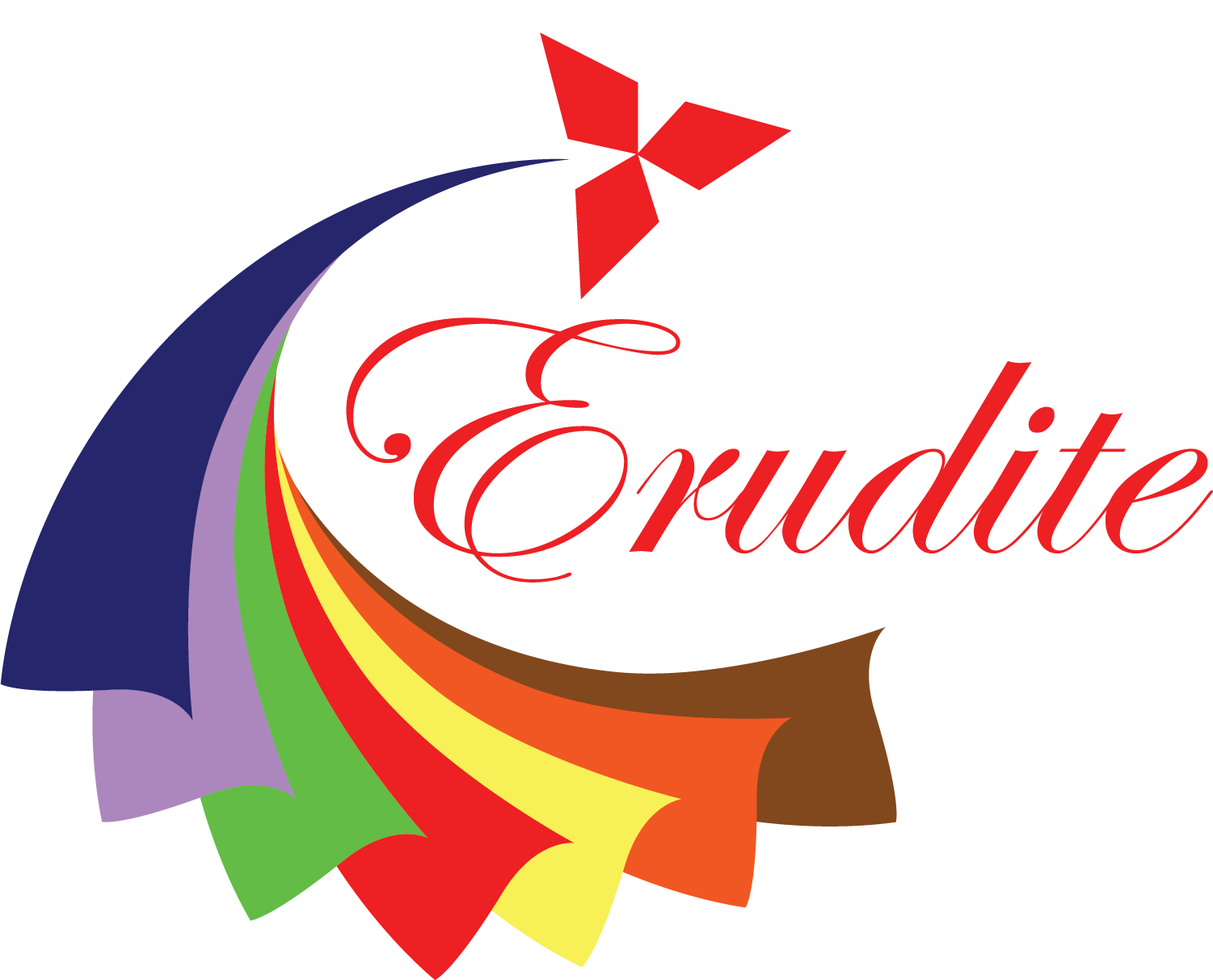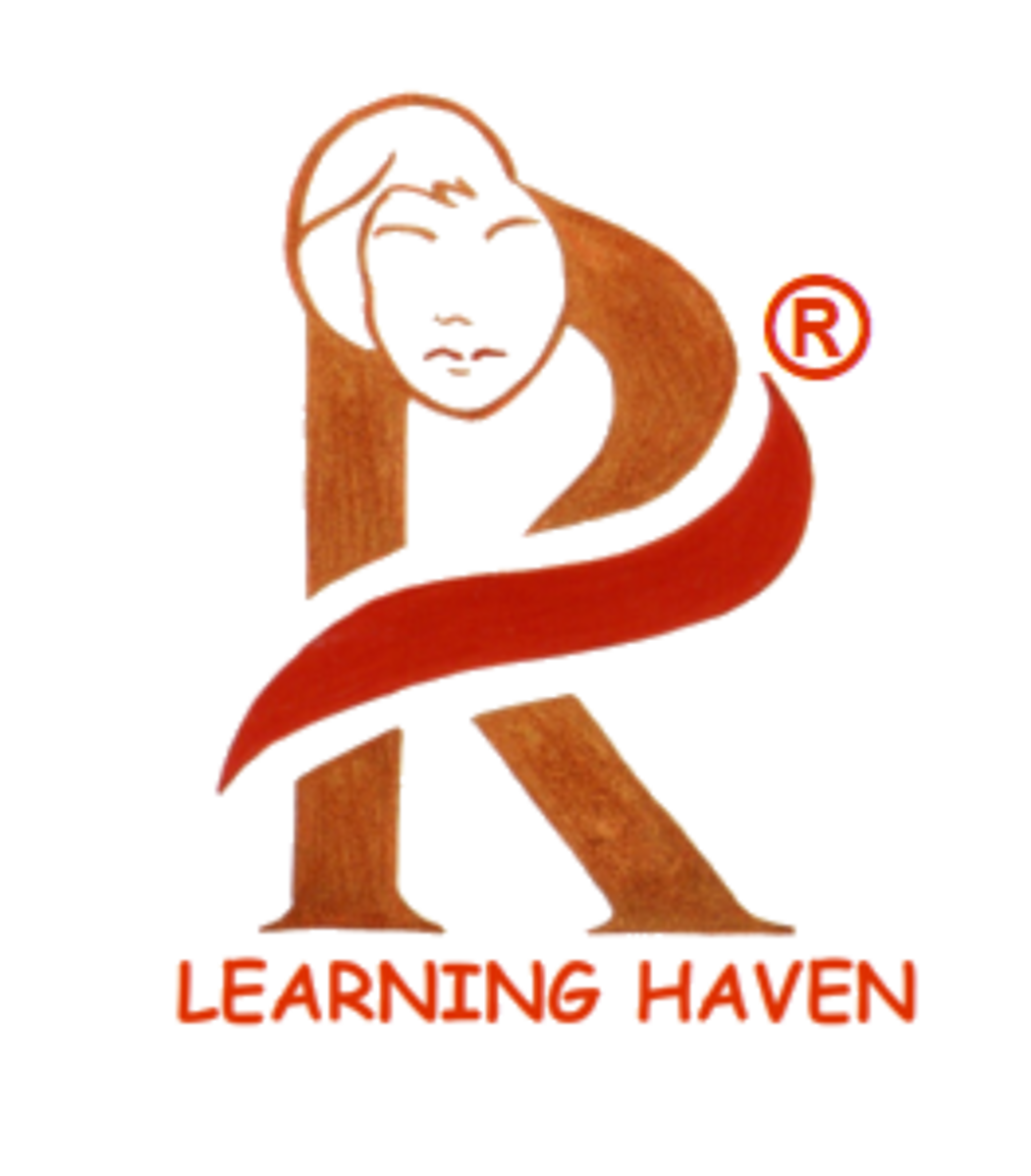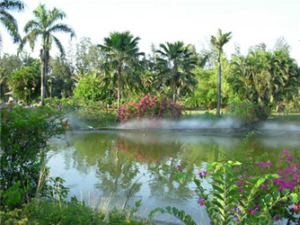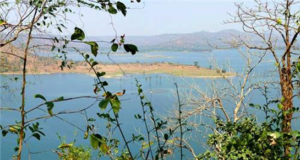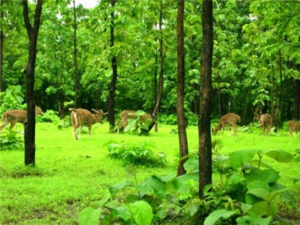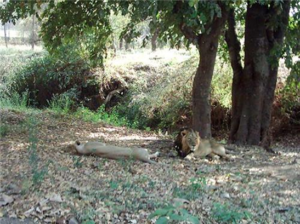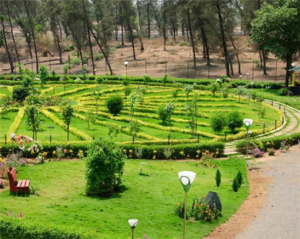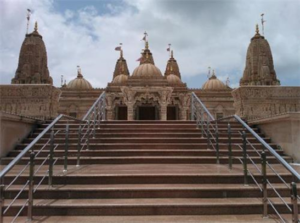Dadra and Nagar Haveli and Daman and Diu
Architecture and History
- India's some of the most elaborate churches and one of the largest sea facing forts of the Indian coast is found in Daman and Diu. Diu largely comprises an island, but it also has a small strip of mainland connected to Gujarat and a tiny beach called Simbor facing an island fort.
- From the beach of Goghla, we drove over the bridge that leads to the main town of Diu, set on the eastern corner of the island. Dominating the townscape are the fort at the eastern edge and the looming churches near the town's western wall.
- The western wall enclosing Diu, are streets lined with grand old houses and mansions with broad balconies, galleries, Gothic arches and porticos. The Nagar Sheth Haveli, is the most elaborate of these houses with intricate stucco work on a colourful façade, stone lions and ornate balconies.
- The monuments include statues, (war) memorials, historical buildings, archaeological sites, and cultural assets.
History
- The documented history of Daman island dates back to the 2nd century when it was a part of a country called Lata till the 13th century. Following this, Daman was ruled by the Mauryan dynasty, Satvahanas, Chalukyas, and Shahs of Gujarat. Later around 1560, came under the occupation and dominance of Portuguese and remained their colony till 1961.
- Diu was a Portuguese colony for almost 450 years, it got liberated along with Dadra and Nagar Haveli, Goa, and Daman. Diu was ruled by a demon king Jalandhar, in the Satyug period, due to which it was called Jallandhar Kshetra. Legends have it that this demon king was beheaded by Lord Vishnu.
- Daman and Diu both were Portuguese colonies before and even after the independence of India. They became a part of the Republic of India in 1961.
- The medieval history of Dadra and Nagar Haveli connects it to the Marathi rule, which subsequently got taken over by the Portuguese around the 18th century. In 1961 it was assimilated into the Republic of India and has been a Union Territory.
- Silvassa is the capital city of Dadar and Nagar Haveli. This UT is spread in an area of 490 square kilometers and has 72 villages in its administration.
- In the year 1262 a Rajput prince from Rajasthan named Ram Singh established himself as the ruler of Ramnagar, the present-day Dharampur, which consisted of 8 parganas (a group of villages) and assumed the title Maharana. Nagar Haveli was one of the Parganas, and its capital was Silvassa.
- In 1360 Rana Dharamshah shifted his capital from Nagar Haveli to Nagar Fatehpur.
- With the rise of Maratha power, Shivaji Maharaj viewed Ramnagar as an important locality. He captured the region, but Somshah Rana recaptured it in 1690. After the Treaty of Vasai signed on 6 May 1739, Vasai and the surrounding territories came under the Maratha rule.
- The Marathas reinstated the ruler, Ramdeo, in Ramnagar under conditions. The Marathas acquired the rights to collect revenue, known as chauthai. from Nagar Haveli and two other Parganas.
- The Portuguese were granted the area of Nagar Haveli on 10 June 1783 on the basis of the Friendship Treaty executed on 17 December 1779 as compensation towards damage to the Portuguese frigate Santana by Maratha Navy in 1772.
- The treaty allowed the Portuguese to collect revenue from 72 villages in Nagar Haveli. In 1785 the Portuguese purchased Dadra, annexing it to Portuguese India (Estado Português da Índia).
- In 1818, the Maratha Empire was defeated by the British in the Third Anglo-Maratha War, and the Portuguese ultimately became the effective rulers of Dadra and Nagar Haveli.
- The Portuguese rule lasted until 1954, when Dadra and Nagar Haveli were captured by supporters of the Indian Union. It was the first colony to be detached from the Empire by the occupation of the Indian Union in 1954, after nearly two centuries of Portuguese rule.
- In 1961, K.G. Badlani an Indian Administrative Service officer became the designated Prime Minister of Dadra and Nagar Haveli and hence became the Head of State. He signed an agreement with the Prime Minister of India, Jawaharlal Nehru, and formally merged Dadra and Nagar Haveli with the Republic of India. The Tenth Amendment of the Constitution of India was passed to incorporate Dadra and Nagar Haveli as a union territory, effective 11 August 1961.
- On 31 December 1974 a treaty was signed between India and Portugal on recognition of India's sovereignty over Goa, Daman, Diu, Dadra and Nagar Haveli.
- In December 2019, the Parliament of India passed legislation to merge Dadra and Nagar Haveli with the nearby union territory of Daman and Diu to create a single union territory to be known as Dadra and Nagar Haveli and Daman and Diu on 26 January 2020. Dadra and Nagar Haveli will be one of the three districts of the new union territory.
Demographic Location
- Situated about 193 km north of Mumbai, Daman lies in close proximity with blue sea, rustic beaches, picturesque villages. It lies sandwiched between Gujarat and Maharashtra. It lies on the banks of the Daman Ganga River.
- Diu encompasses an island off the southern coast of Gujarat's Kathiawar Peninsula, almost 64 km southeast of Veraval, as well as a small area on the mainland.
- Both the Districts of Daman and Diu are near Gujarat State surrounded by Valsad District of Gujarat State in North, East and South.
- Daman lies on an alluvial coastal plain, although outcrops of basalt create low plateaus and promontories in the area. The Daman Ganga River flows through the territory, with Daman town situated where the river enters the Arabian Sea.
- Forests cover some two-fifths of Dadra and Nagar Haveli. The terrain is undulating and hilly, reaching elevations of 1,000 feet above sea level in the northeast and east near the Western Ghats.
- Lowland areas are limited to the central plains, which are crossed by the Daman Ganga River and its tributaries.
- The sylvan mountains of Dadra and Nagar Haveli mainly occupy the north - eastern and eastern part of the union territory. The Sahyadri mountains belonging to the Western Ghats make the hilly terrain in this part.
- The natural lush green forests, meandering rivers, distant mountain ranges and a magnificent kaleidoscope of flora and fauna represents the topography of the Union Territory.
- The major river Daman Ganga and its tributaries cuts across the Dadra Nagar Haveli and drain into the Arabian Sea at Daman.
- The central alluvial region of the land is almost plain and the soil is fertile and rich. The river Daman ganga rises in the Ghat 64 km from the western coast and discharges itself in the Arabian Sea at the port of Daman after crossing Dadra and Nagar Haveli. Its three tributaries, Varna, Pipri and Sakartond, join Daman Ganga within the territory.
- The area of Dadra and Nagar Haveli is spread over 491 square kilometres (190 sq mi). The region is land locked between Gujarat to the north and Maharashtra to the south.
- Dadra and Nagar Haveli comprises two separate geographical units. The larger part—Nagar Haveli—spans a roughly C-shaped area upriver from the city of Daman on the coast, at the centre of which, straddling the border with Gujarat, is the Madhuban reservoir. The smaller enclave of Dadra is a short distance to the northwest.
- Dadra and Nagar Haveli is in the middle of the undulating watershed of the Daman Ganga River. The towns of Dadra and Silvassa lie on the north bank of the river. The Western Ghats range rises to the east, and the foothills of the range occupy the eastern portion of the district.
- Dadra and Nagar Haveli is surrounded by Valsad District of Gujarat on the west, north, and east, and by Thane District of Maharashtra on the south and southeast.
People, Rituals and Language
- Gujarati is an important member of the family of Languages of Dadra and Nagar Haveli.
- It is an Indo Aryan Language and a direct decedent of Sanskrit. It is the chief language of the State of Gujarat but it is also widely spoken in the two Union Territories of Dadra and Nagar Haveli and Daman and Diu.
- Most of the people speak in Gujarati, Hindi, English and most old people speak Portuguese.
- There are a few convent schools that still teach Portuguese and French along with English and Hindi.
- Warli is the local language spoken by the Warli people. Agri the dialect of Marathi which is spoken by Agri community.
- The languages taught in schools in Dadra and Nagar Haveli under the three-language formula are as follows:
- First Language: Gujarati, Hindi, Marathi
- Second Language: Marathi, Gujarati
- Third Language: English
- The main Languages of Dadra and Nagar Haveli includes Marathi, Gujrati, Bhili and Bildoli.
- Bhili originated as a Western Indo- Aryan Language and is spoken in many parts of Central India. Bhili is also known as Bhilboli, Bhilla, Bhagoria, Bhil, Bhilbari, Lengotia, and Vil. This Language of Dadra and Nagar Haveli is related to Gujarati and Rajasthani Languages and is written by using variations of the Devanagari script.
- Marathi is widely spoken in Dadra and Nagar Haveli. A 150 years old language, the grammar and syntax is derived from the Pali and Sanskrit Languages.
- Gujarati is an important member of the family of Languages of Dadra and Nagar Haveli. It is an Indo Aryan Language and a direct decedent of Sanskrit. Marathi, Gujarati, Bhili/ Bildoli are among the most widely used Languages of Dadra and Nagar Haveli.
Season and Climate
- Daman & Diu - the two islets - features a subtropical climate.
- Being closely located in the sea, the Daman weather is cool, calm, and breezy. It receives heavy monsoons with lots of rain. There is not much difference between winter and summer. The standard rainfall recorded in Daman &Diu is 1687 mm.
- The summers are hotter in Diu compared to that on the island of Daman. Winters are the perfect time to visit these enchanting islands for a splendid vacation.
- The weather of Daman & Diu features low moisture levels. It is cool and dry throughout the year. The pleasant breezes from the Arabian Sea flow to bring down the average temperature of Daman & Diu. The summer season is quite hot. However, winters are cool and mild .
- In the Summer months, Dadra and Nagar Haveli Weather is marked by warm and humid weather system for both day and night.
- The South West Monsoon winds brings considerable amount of rain and humidity in the region between June and September. In the Winter months the Dadra and Nagar Haveli Weather becomes very pleasant and remains so from the month of November to March.
- Winter and Spring season, are very pleasant and mild.
- Nearness to the coast, defines the climate of the region with a typical north Indian Ocean maritime type of climate. The summers are hot and more humid during evening.
Culture and Education
- The culture of these twin islands is colorful and vibrant. All the festivities involve elaborate feasts, dance, music, drinking, singing, and spreading joy.
- The major dance forms that have been a part of Daman and Diu culture have Portugal traces, and the most popular among them are Vira Dance, Mando Dance, and Verdigao Dance. Besides these Portugal dance forms, people also perform Gujarati dance forms like Garba at folk festivals and special occasions.
- Daman and Diu have Gujarati influence on lifestyle, culture, and food. Mat weaving is an art that fascinates tourists from across the globe. Besides mats, some other artisan and craftsmen work are made of ivory and seashell carving and tortoise shell craft done by local artists.
- The food of Daman and Diu has flavors of its colonial roots and the nearby cultures such as Gujarati, Maharashtrian, and Goan.
- Diu serves the best seafood comprising lobsters, crabs, and fish. Daman, on the other hand, serves authentic Gujarati and Portuguese food. The most popular among them are Papri, Chicken Bullet, Parsi Kheema, Akuri, Aleti Paleti with Chicken Liver, Cozido, and Fish Koliwada. Basundi and Lapsee are the two local sweet dishes that are hard to resist.
- Literacy rate in Daman and Diu has seen upward trend and is 87.10 percent as per latest population census.
- More than 68 percent of district population resides in villages (21 in number) whose main occupation is fishing, agriculture and working in non agriculture sector.
- The tribals (schedule caste and tribe) constitute about 12 percent of total population. The religious customs of the majority population are no different from the people in the adjoining Gujarat area.
- Gujarati is the predominant language of this region and is the most widely spoken. The language of the official work is English. Hindi is understood by a vast majority of the people even in rural areas.
- Customs of birth, marriage sacred thread, other ceremonies ad rituals are religiously observed. Tribal dances with caustic social emotions are popular Various Portuguese dances are well preserved and still widely presented.
- All the festivities involve elaborate feasts, dance, music, drinking, singing, and spreading joy. The major dance forms that have been a part of Daman and Diu culture have Portugal traces, and the most popular among them are Vira Dance, Mando Dance, and Verdigao Dance.
- The culture of Diu is unique as it is a blend of Kathiawadi (Saurashtra) and Portuguese culture. Hindu, Islam and Christianity prevail on the island. The administration of Diu conducts the Diu Festival annually on December 19th, the Liberation Day of Diu.
- African and Indian origin have settled in Daman. The influence of these diverse cultures is evident in the dance, food and music of Daman. Different dance forms, like the Verdigao, Vira and Mando show strong Portuguese influence.
- The major tribes of the region are Dhodia, Kokna and Varli. Some of the other tribes living in the area are Koli, Nayakas, Kolghas, Kathod, Naika and Dublas tribes can be found all over the territory of Dadra and Nagar Haveli. Naika is one of the tribes that live in Dadra and Nagar Haveli.
- Some of the famous vibrant festivals of these tribes, which even indicate season change, are:
- Akha Tij: This is a small festival of the women community of the Kokhna tribe.
- Barash: The tribes of Kokna and Varli celebrate this festival of Barash during Diwali. They celebrate this as a festival similar to Diwali.
- Raksha Bandhan and Divaso: With a belief that Goddess Kali's good spirit is invoked in the villages during crop harvesting, this is a popular festival of the Dhodias.
- The tribal dances in Dadra and Nagar Haveli are of many types, each of which is unique in their styles. The tribal dances in the union territory of Dadra and Nagar Haveli are as follows:
- Bhavada Dance
- Tarpa Dance
- Bohada Dance
- Tur and Thali Dance
- Dhol Dance
- Gherria Dance
- The dances are accompanied by different kinds of musical instruments that are created by the tribal people themselves made by locally found materials like:
- Bamboo
- Gourd
- Leather
- Wood
- The natural beauty of the region and their colorful customs are reflected in the vibrant Fairs & Festivals of Dadra and Nagar Haveli. Some of the major Fairs & Festivals of Dadra and Nagar Haveli are:
- Akhatrij
- Divasol
- Nariyal Poornima
- Tarpa Festival & Craft Mela
- Monsoon Magic Festival
- Children's Film Festival
- The culture of Dadra and Nagar Haveli is a fusion of mainstream cultures and tribal culture. Mainstream festivals like
- Ganesha
- Chaturthi
- Navratri
- Makar Sankranti
- Christmas,
- Id-E-Milad
- Pateti
- These festivals are celebrated with similar enthusiasm as in the rest of the country. Some popular tribal festivals are
- Tarpa Festival
- Divasol
- Akhatrij
- Nariyeli Purnima
- Monsoon Magic Festival
- There are no universities in Dadra and Nagar Haveli. Colleges in the territory include Dr. A.P.J. Abdul Kalam Government College, Silvassa, SSR college of arts, science and commerce, shrimati Devikaben Chauhan college.
- The union territory also has a government medical College Shri Vinobha Bhave Institute of Medical sciences affiliated to Veer Narmad South Gujarat University.
Famous Spots
- Somnath Mahadev Temple,
- Mirasol Lake Garden,
- Jampore Beach,
- Devka Beach,
- Ghoghla Beach,
- Nagoa Beach, and
- Jallandhar Beach.
- Ancient temples and churches like St Jerome Fort and Gangeshwar Mahadev Temple.
- Try Horse Riding at Jampore Beach.
- Mirasol Lake Garden.
- Parasailing, Jet Skiing, Scuba Diving, Speed Boat Ride, and WindSurfing in Arabian Sea.
- Mirasol Water Park is a must-visit place to spend a fun-filled day with kids.
- The Cathedral of Bom Jesus,
- Dominican Monastery,
- Jetty Garden,
- INS Khukri Memorial,
- Paul Church,
- Gangeshwar Temple is best known for its subterranean cave like shrine with Shivalingams facing the sea.
- The sandy beach of Jilander or Jalandar offers a view of the glorious sunset on the Arabian Sea.
- INS Khukri is a memorial to a British Type 14 frigate of the Indian Navy that was sunk off the coast of Diu during the 1971 Indo-Pak War.
- Chakratirth is a large and attractive beach with lovely sand and small dunes. This beach offers a delightful view of the sunrise to its east and sunset to its west.
- Malala is one of the greenest areas of Diu, inhabited by leopards and the Nilgai antelope. It has an auditorium and a solar power plant near the Parsee well.
- Vanakbara is a picturesque fishing village and a centre for boat building.
- Gomtimata Temple near Vanakbara village is located facing a virgin beach, little known to tourists.
- On the mainland, the Ghogla beach is one of the finest beaches of Diu, with lovely sands and a good view over the creek to the monuments of Diu. The Fort St. Anthony of Simbor can be seen from the beautiful beach here.
- Vanganga Lake is one of the most popular tourist attractions of Dadra and Nagar Haveli, Vanganga Lake is situated just five kilometers from Silvassa. Stretched over an area of 7.8 hectares, the lake is surrounded by a beautiful well-maintained park with jogging tracks, thatched huts and Japanese style wooden bridges. Vanganga Lake is known for its maintenance and cleanliness.
- Hirwa Van Garden is an interesting man made forest, situated near Khanvel on the Silvassa-Dadra Road in Piparia. Surrounded by beautiful cascading waterfalls, stonewalls, twin arches and expansive lawns, Hirwa Van Garden is also a popular picnic spot. This place is also perfect for camping and other outdoor activities.
- Dudhoni is situated about 40 kilometers from the capital city of Silvassa, Dudhoni is a popular spot located on the waterfront of River Damanganga and Madhuban Dam. This place is known for its wonderful range of water sports such as rowing boats, canoes, kayaks, water scooters, jet skis, shikaras – residential boats and motorized speed boats.
- Satmaliya Deer Park is spread over an area of almost 750 acres, Satmaliya Deer Park is a huge park located at Dapada on the Khanvel – Silvassa Road. The park is home to a wide array of deer species including Chinkara, Black Buck, Sambhar, Spotted Deer, Four – Horned Antelope, Nilgai.
- Vasona Lion Safari located about 20 kilometers from the capital city of Silvassa, This Safari was built with the objectives of preserving Asiatic lions and lionesses, to track their breeding and to provide them with medication and food.
Nakshatra Garden
Located in the capital city of Silvassa, Nakshatra Garden is a one-of-a-kind, astrology based garden that includes various interesting components such as Grah Van, Raashi Van, Nakshatra Van and a section only for medicinal plants. The garden is known for its wide variety of colorful shrubs, kiosks and cut across footpaths.
Religious Places in Dadra and Nagar Haveli
Some popular religious places in Dadra and Nagar Haveli, include Bindrabin Temple, Tirupati Balaji Temple, Swaminarayan Temple, Church of Our Lady Piety and Saint Thomas Church.
Aqua, Flora and Fauna
- Fauna treasure like Pearl millet, Bitter melon, Crested cockscomb, Gophertail lovegrass, Grasslike zornia are found in Daman and Diu.
- Wildlife sanctuary is a home for many antelope species such as ndian Spot-billed Duck, Chital, Nilgai, Sambar, Chinkara and Blackbuck. Other species like Indian peafowl, Flameback Woodpecker, Thrushes etc can also be found.
- DNH has two major forest types: tropical moist deciduous forest and tropical dry deciduous forest. The major produce is khair wood and general timber. Teak, sandra, khair, mahara and sisam are the major tree species in the region.
- Animals and birds native to Dadra and Nagar Haveli are leopards, Golden Deer, Four horned Antelope, Striped Hyena, Black Drongo, Bulbul and Heron.
- The Hokka Trees (Strange Palm Tree) at Diu are unique and are not found anywhere else in India. The fruits of these trees are edible and have medicinal properties.
- Daman is primarily an agricultural district with paddy and pulses (red vaal) as the predominant crops. The other major crops cultivated are mango and coconut. However, due to rapid industrialization, the share of agriculture sector in employment is reducing day by day in Daman.
- Fudam Wildlife Sanctuary established in 1991. It is marshy land and located in Diu. Mangrove scrub and several bird species are found in the Fudum Bird Sanctuary.
- The rich biodiversity makes it a habitat for a variety of birds and animals and thus a destination for inland and coastal safari and eco-tourism.
- Dadra and Nagar Haveli lies within the North Western Ghats moist deciduous forests ecoregion, characterised by forests of teak (Tectona grandis) and other dry-season deciduous trees. Teak, sandra, khair, mahara and sisam are the major tree species in the region. Silvassa, Brown-beard rice,
- Heart of jesus, Mango tree, Dieffenbachia, Chinese hibiscus, are the flora reserves found in Dadra and Nagar Haveli.
- Animals found are Sambhar and Chital deer, and blackbuck and a wide variety of birds like the flame back woodpecker, peacocks, and thrushes. The Gray-headed Canary-Flycatcher is found here.
- The Watchtower near the water hole provides an panoramic view of the sanctuary and Madhuban Dam.
- In the surrounding region, the city of Luhari, only 14km away and is a region of rich forest cover and is surrounded by green hills.
- The Sakartod river flows nearby, and you can spot flying foxes, flycatchers and barbets in the forest. Vasona is known for its Lion Safari. The area is spread over 20 hectares, and visitors are taken in vans to closely admire the beauty of the Lions and other fauna of the region.
- Satmalia Safari has many species of Antelope and many other animals, including blackbuck, and varieties of Deer, not to mention a rich variety of birds in the region.
- Animals and birds native to Dadra and Nagar Haveli are leopards, Golden Deer, Four horned Antelope, Striped Hyena, Black Drongo, Bulbul and Heron.
- Silvassa's hills and wide, forested buffer land attract wildlife enthusiasts.
- About 43% of the land is under forest cover. The protected forests constitute 2.45% of the total land area.
